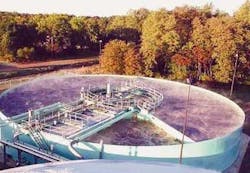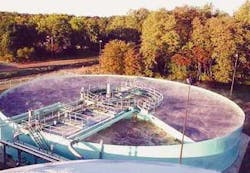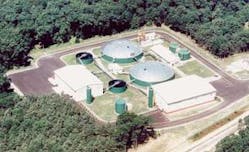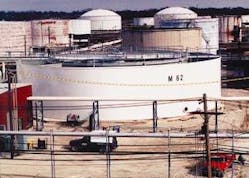By Donald J. Aholt
A new custom designed aerobic wastewater treatment system provides stable operation and flexible process options that can be tailored to meet the specific requirements for industrial wastes.
The precursor of the Model R Oxigest® Treatment System was originally developed by the engineers at Smith & Loveless for treatment of domestic wastes, but after nearly four decades of continued development and evolution, the system has evolved into a treatment plant that can be custom-designed for a wide variety of industrial wastewater streams.
The Oxigest design parameters include flow capacities of 0.1 mgd up to 5 mgd in a single tank with waste strengths up to 5,000-7,000 mg/l BOD, 10,000-15,000 mg/l COD and 6,000 mg/l TSS. It can serve as pretreatment for either sewer or stream discharge, be used as a polisher to anaerobic reactors, or incorporate into a recycle stream.
The system's "smart-tank" design encompasses aeration, clarification and advanced treatment in concentric tankage while allowing these unit processes to be individually separated and controlled. Its circular exterior allows the treatment package to fit with other tankage often used at industrial facilities and plants, and maximizes space efficiency in its footprint, thereby preserving facility land for other key plant operations.
Circular steel tankage is also the most durable package design for retaining large volumes of wastewater while minimizing the use of steel and lowering raw material cost. In colder climates, the system's tankage minimizes surface area exposure to the elements, which saves heat and protects the biological operation.
The Oxigest system is equipped with components that offer process control and automation throughout the plant's operation. Wastewater that enters the system can feed directly into an aeration zone or via one of two other zones: either a moderately aerated equalization zone, for stabilization of flow and organic loading, or a selector zone, which mixes with RAS solids in an anoxic environment to yield short periods of low dissolved oxygen for the prevention of undesirable bacteria.
The influent then passes into the aeration zone, which includes air diffusion equipment designed for efficient oxygen transfer, effective mixing and minimal energy usage. Certain diffuser grids can be adjusted within the aeration zone to optimize treatment. The aeration zone also contains integral instrumentation for process monitoring of pH, dissolved oxygen, mixed liquor suspended solids (MLSS), and temperature levels, which allows the system's operator to control the plant from a remote operations room or on-plant.
For high-strength applications, multiple aeration zones can be employed to provide specific activated sludge processes for desired treatment levels, depending on the type of waste. Processes include multi-stage aeration, complete mixed, plug-flow and nitrification/denitrification. Inlet distribution headers help evenly distribute the incoming load to the biomass within the aeration zones while outlet distributors evenly collect treated wastewater for input to the clarifier.
The addition of multiple zones not only offers the benefit of handling variable load conditions but also provides service convenience and continuous operation. If the occasion arises, certain zones can be off-line for draining and service while others are operating.
Once the influent wastewater is treated in the aeration phase, it enters the integral clarifier, in the center of the plant. Like the process flexibility featured in the aeration phase, the Oxigest system also offers various clarifier options, including center-feed, peripheral-feed and flocculating with both half-bridge and full-bridge designs available. Each clarifier design offers Smith & Loveless' skimmer system, which consists of a skimmer arm, anti-rotation arm, and airlift removal. The skimming arm works in concert with the anti-rotation arm to force all surface material toward a scum baffle for removal by an air-driven pump.
Air-driven pumps are also used for RAS/WAS functions. These air-driven pumps are non-mechanical and stainless constructed, and can be equipped with automation capabilities to adjust RAS/WAS rates from a remote location or on-plant. The pumps also allow for sampling of the actual underflow sludge level to determine solids concentration and settleability, and perform microscopic examinations. A flow transmitter can be incorporated for remote monitoring of RAS/WAS rates as well. Additionally, a perimeter walkway encircles the entire clarifier for 24-hour access and up-close examination.
The Oxigest's flocculating clarifier offers components (for solids and/or nutrient level control) which accomplish variable G-factor flocculating intensities (for either mechanical and/or air induced flocculating). This affords the end-user an efficient use of flocculants, which results in lower operating costs while enhancing flocculation and settling.
Because the clarifier is integral, it makes the entire treatment scheme space-efficient for industrial facilities. It also reduces capital costs because its concentric tankage reduces the use of interconnecting piping, external mechanical pumps, valves and the capital costs associated with multiple basins and tanks.
Following clarification, the Oxigest can be designed for inclusion of a variety of post-process variations, including nitrification/denitrification, re-aeration, chlorination, dechlorination, sludge storage, tertiary filtration or other specialized treatment. Most systems incorporate sludge holding, which allows for further bio-degradation and digestion. The plant's automated thickening and decanting capability maximizes solids concentration while minimize the sludge volume to be disposed. This automated feature can further reduce operator time and attention and make control more precise.
About the Author: Donald J. Aholt is Vice President of Smith & Loveless Inc.'s Industrial Products and Systems Division. He received his Bachelor of Science degree in Mechanical Engineering and his Master of Science degree in Environmental Engineering from the University of Missouri.





